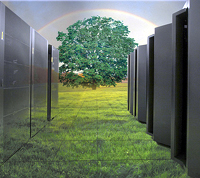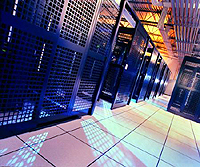
The Green Data Center
Greening Up your Data Center from the Inside Out.
Part 1 and 2 of this series dealt with server consolidation and access to green energy as ways to help reduce your company’s carbon footprint. This article gives you front-line knowledge about Data Center energy efficiency changes that really work and don’t require large capital investment.
Every DC is different, so we’ll focus on general things that should work no matter how your DC is configured. One of the best places to start is getting a LEED assessment of your building(s). The Leadership in Energy and Environmental Design (LEED) Green Building Rating System™ is the nationally accepted benchmark for the design, construction, and operation of high performance green buildings. This assessment will provide you with a baseline report with current and potential scores based on criteria like whether your air conditioning has an economizer mode.
The bank where I worked had an assessment done for our DCs and it identified several quick and inexpensive changes:
- Monitor computer room humidity and program all AC units to operate in a way that prevents them from “fighting” each other (one unit humidifies while another dehumidifies).
- Measure the cycling of AC units within your cross connect and high density rooms so that only the units required for cooling the load are operating, leaving the remaining units in a standby mode. Be sure to switch “lead” and “backup” AC units on a regular basis to avoid over-stressing one unit.
- Conduct a raised floor survey to verify floor cut-outs and penetrations are plugged and hot-cold aisles are configured correctly; resolve as necessary. This will need to be monitored and changed as your DC configuration morphs over time.
- Check your server operating specs; you can often increase the raised floor ambient temperature and broaden your humidity set points.
- Replace 30W fluorescent bulbs with 25W and turn off lights where no work is being done.
- Utilize the power saving abilities on technology equipment. Many items don’t need to be running at full power 24/7, so have your staff look for opportunities (i.e., monitors can be allowed to turn off completely during non-use, new servers and power supplies will draw only the electricity they need).
The bank LEED assessment also provided numerous changes we could perform with medium to high cost investment. The payback on those investments should be measured broadly across your company’s triple bottom line.
Learn more about LEED, and about BREEAM in the EU.
Here are some of the other efficiency ideas that came out of our LEED assessment and other Green-Storming sessions:
| Recommendation | Implementation Expectations* | |||
| Cost | Time | LEED | ROI | |
| Value | ||||
| Develop a policy to purchase servers with >90% efficiency power Supplies. | Low | Short | NA** | High |
| Replace AC power with DC to reduce heat loads. | High | Long | NA** | High |
| Install blanking panels. | Low | Short | NA** | Med |
| Install new flush valves and flow restrictors in restrooms at EDC1. | Low | Short | 2 | Med |
| Ensure all water fixtures meet the EPAct 1992 efficiency Standards. | Low | Med | 0.5 | Med |
| Install occupancy sensors on raised floor lighting. | Med | Med | 1 | Med |
| Implement vibration analysis on fans, pumps, etc. to improve efficiency. | Med | Med | NA** | Med |
| Use highly efficient and/or non-potable water for landscape irrigation. | Med | Med | 1 | Med |
| Mitigate storm water run-off, such as rainwater storage. | Med | Med | 1 | Med |
| Replace existing fans on computer room ACs and RTUs with premium efficiency (>92%) motors. | High | Long | NA** | Med |
| Install new Central Plant and chilled water distribution system. | High | Long | NA** | Med |
| Implement on-site, alternative energy sources, such as wind, solar, and fuel cells. | High | Long | 3 | Med |
| Provide preferred parking for carpool at sites. | Low | Short | 1 | Low |
| Purchase electricity from renewable generation sources. | Low | Med | 1 | Low |
| Shield all outdoor luminaries over 50W so no light is emitted to the night sky. | Low | Med | 1 | Low |
| Implement and document technician training and monitoring practices of O&M procedures. | Low | Short | 2 | Low |
| Add meters for humidifier and irrigation water supplies. | Low | Short | 1 | Low |
| Provide adequate outside air and monitor CO2. | Med | Med | 2 | Low |
| Add bicycle storage and changing/locker rooms. | Med | Med | 1 | Low |
| Restore nearby company owned native land. | Med | Long | 0.5 | Low |
| Replace existing transformers with Energy Star Transformers. | High | Long | NA** | Low |
| Confirm/improve Solar Reflectance Index of roofing material; use high emissivity and high-reflectance roofing material at roofmeeting ASTM 408 for 75% of roof. | High | Long | 1 | Low |
| Provide shade for 30% of parking lot and walkways to reduce heat island effect. | High | Long | 0.5 | Low |
*Cost range is defined as such: Low is <$50k, Med is $50k to $200k, and High is >$200k
*Time range is defined as such: Short is <60 days, Med is 60 to 180 days, and High is >180 days
*ROI range is defined as such: Low is <1.0, Med is 1.0 to 3.0, and High is >3.0
**Recommendations all aim at improving efficiency with potential LEED point gains between 2 to 7.
—
Next time: “Encouraging Invention and Innovation Globally.”



 Posted by Todd Rawlings
Posted by Todd Rawlings  When most IT managers think of DC efficiency, they jump right to the topics making the most headlines, “Strategic hot and cold server rows, high efficiency power supplies, LEED certification analysis and building retrofits, etc.” Yes, I’ll cover those things in some detail in Part 3, but one of the most effective and least costly ways to cut your total electricity usage (and therefore your company’s
When most IT managers think of DC efficiency, they jump right to the topics making the most headlines, “Strategic hot and cold server rows, high efficiency power supplies, LEED certification analysis and building retrofits, etc.” Yes, I’ll cover those things in some detail in Part 3, but one of the most effective and least costly ways to cut your total electricity usage (and therefore your company’s